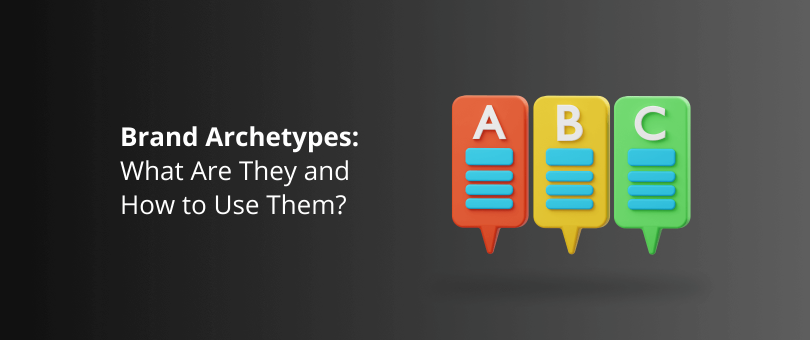What is the one thing all successful brands have in common? The thing that makes them stand out in the crowd and connect with their followers on an emotional level?
You are probably thinking of logos, distinctive ad copy, and viral video ads. And you are not entirely wrong, these are all part of it. However, the correct answer is – a distinctive brand archetype.
But what does brand personality type mean exactly?
Well, what comes to mind when you think about Netflix, Disney, or Apple? Do words like chill, magical, creative come to mind?
This is how brand archetypes work.
In its essence, a brand archetype reflects the personality type and identity of brands. It’s a framework that helps businesses build a human-like personification that allows them to better align the spirit of the brand with their target customer’s profile.
The concept of brand archetypes is a universal idea that has proven its efficiency over time. Businesses that understand the psychology behind branding and manage to successfully incorporate it into their strategies can build distinctive brands with strong communities. Ultimately, this leads to better commercial success.
In this article, we delve into the world of enterprise branding by exploring the 12 brand archetypes. We discuss what these archetypes are, how they relate to brands, and why leveraging them can be beneficial for your business.
What Are Brand Archetypes?
The term archetype was pioneered by psychologist Carl Jung and supports the theory that people can understand complex concepts better through symbolism. Jung argued that there are certain images and forms of collective nature that exist all over the world, which help us recognize patterns and make sense of our environment.
He called these archetypes – a compilation of brand personality types based on key human values and desires like belonging, power, and safety.
Related: How to Find Your Brand Personality
In marketing, archetypes have been widely used in branding and are commonly referred to as brand archetypes. Their purpose is to build a narrative and create an emotional bond between the business and its target audiences.
The best brand personas match the core archetype that is truest to their brand’s mission, vision, and values. This enables followers to identify with the brand, and feel they belong. The connection is based on the common brand personality traits they share or the types of role models the person looks up to.
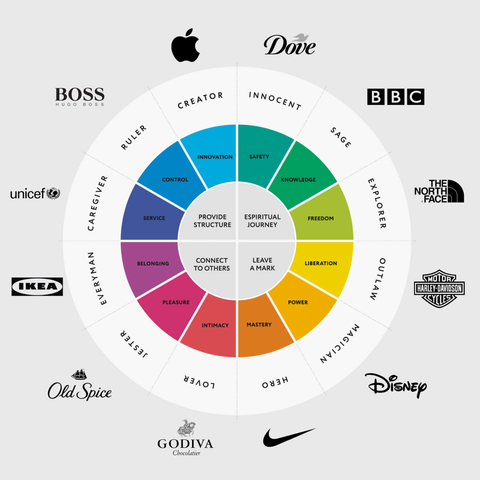
Taking a Closer Look Into the Brand Archetype Wheel
There are 12 brand archetypes that businesses can base their identities on. To contrast and group them, they are often presented on a brand archetypes wheel.
Let’s take a look at what defines each:
1. The Innocent
Brands within the innocent archetype exhibit optimism, happiness, and goodness. They crave safety, actively stay away from ill-will, and view the world as fun and wonderous. These brands thrive when they can spread joy, and rely on honesty, simplicity, and good virtue instead of innovation.
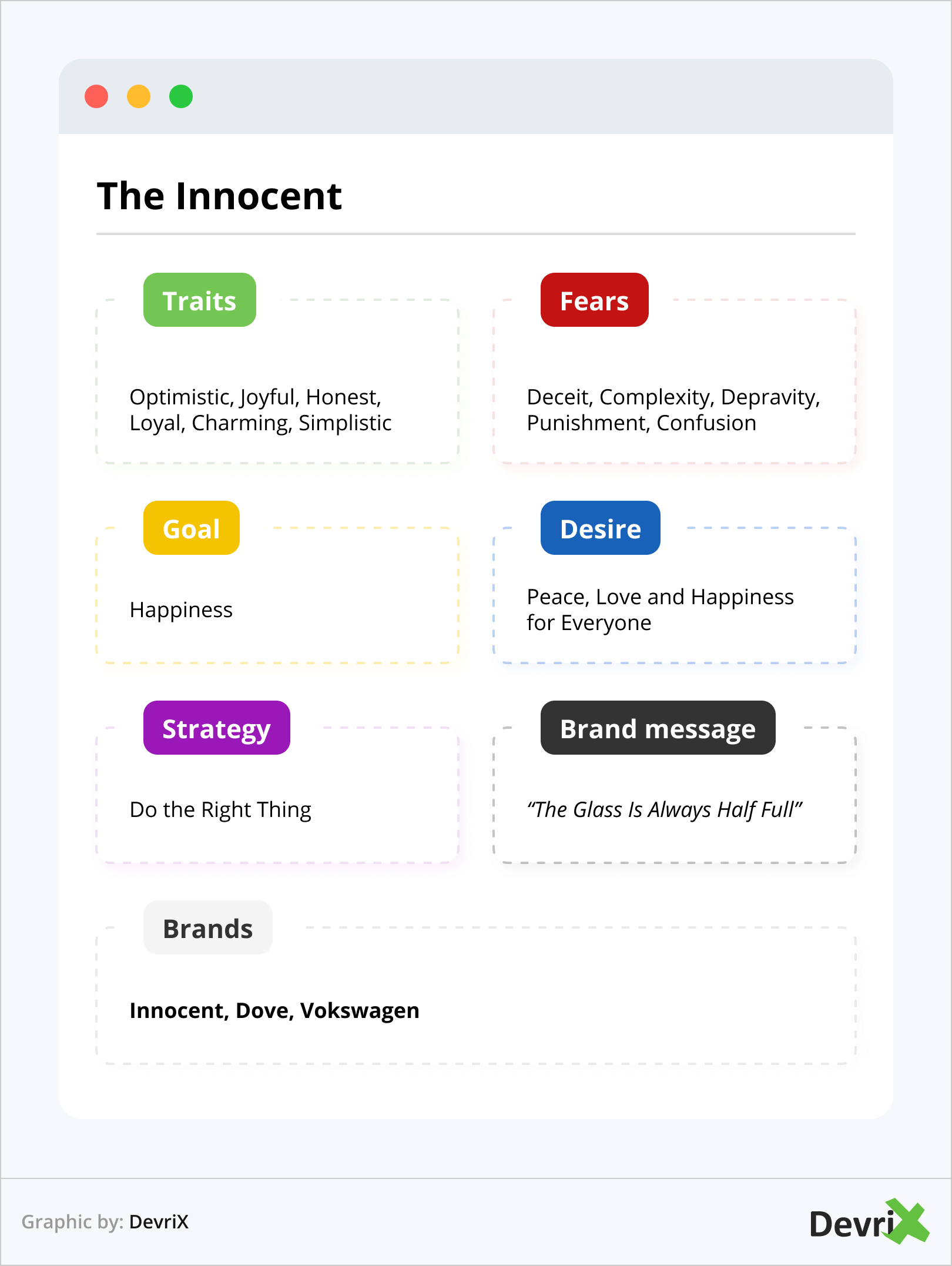
2. The Sage
The Sage archetype embodies wisdom and deep insights. It’s the embodiment of a thoughtful advisor or mentor.
Brands within this archetype believe that the truth will set you free. They don’t strive to change the world but instead aim to empower others to do so by providing them with valuable information. As such, they are usually excellent mentors, thought leaders, and life-long learners
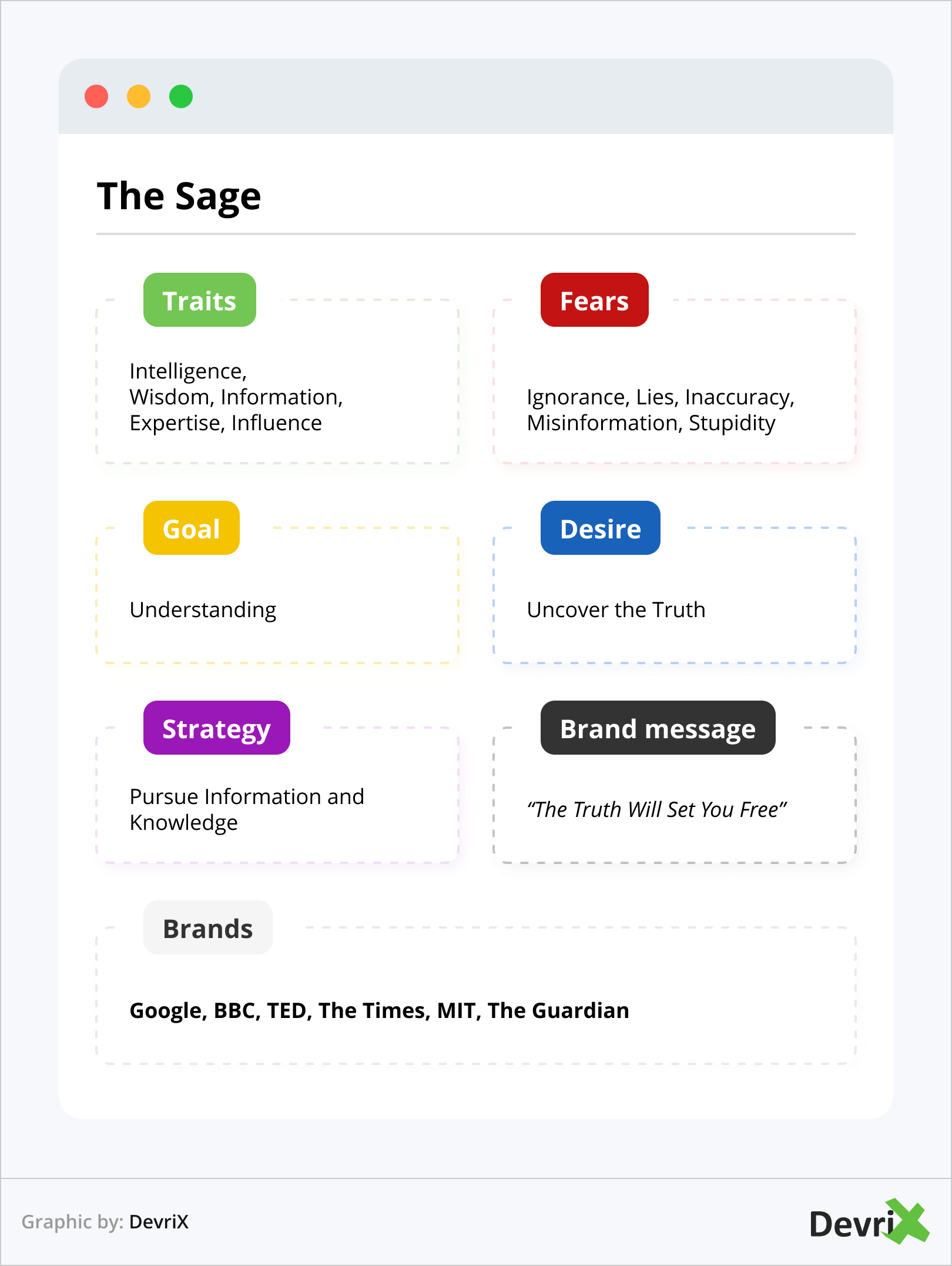
Related: Why Brand Ethics Is Important for Companies [Examples Included]
3. The Explorer
Brands within the Explorer archetype find inspiration through the thrill of the new. They like to explore and are driven by the desire for independence and freedom. These brands like to push themselves into the unknown, take risks, and take on new challenges. They are adventurous and brave and hate conformity.
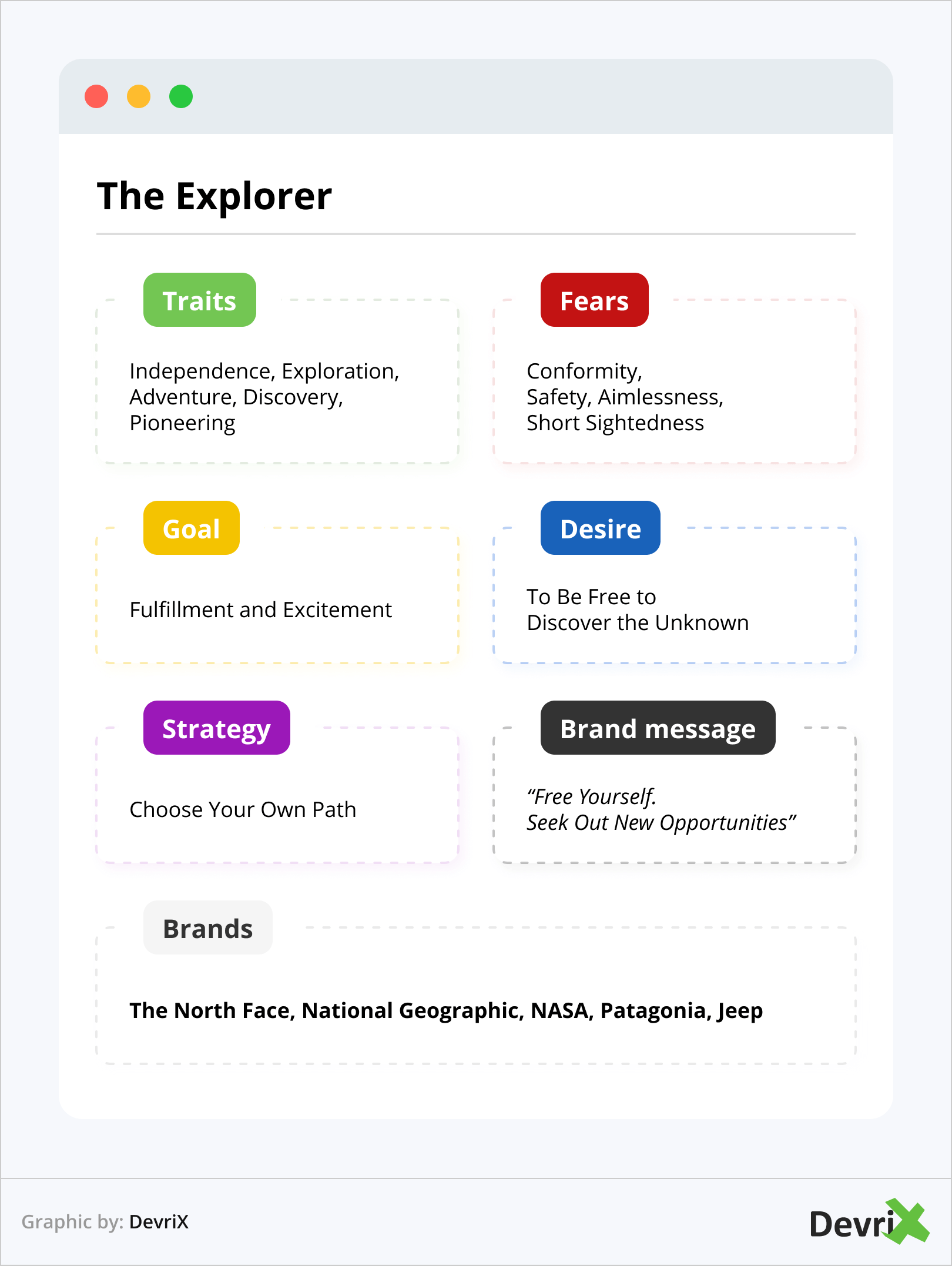
4. The Outlaw Type
The Outlaw archetype in branding, also known as the Rebel, has a burning desire to question authority and, true to its name, break the rules.
These rebels seek to challenge the status quo and disrupt their industries. Just like explorers, rebels actively strive to dismantle existing paradigms and toss out the rulebook. They work towards setting themselves free, taking risks to create something truly unique in the realm of brand archetypes and inspire others to do the same.
Because of their disruptive nature, they don’t appeal to everyone. Instead, they tend to create a cult-like following, building strong brand loyalty amongst a particular niche.
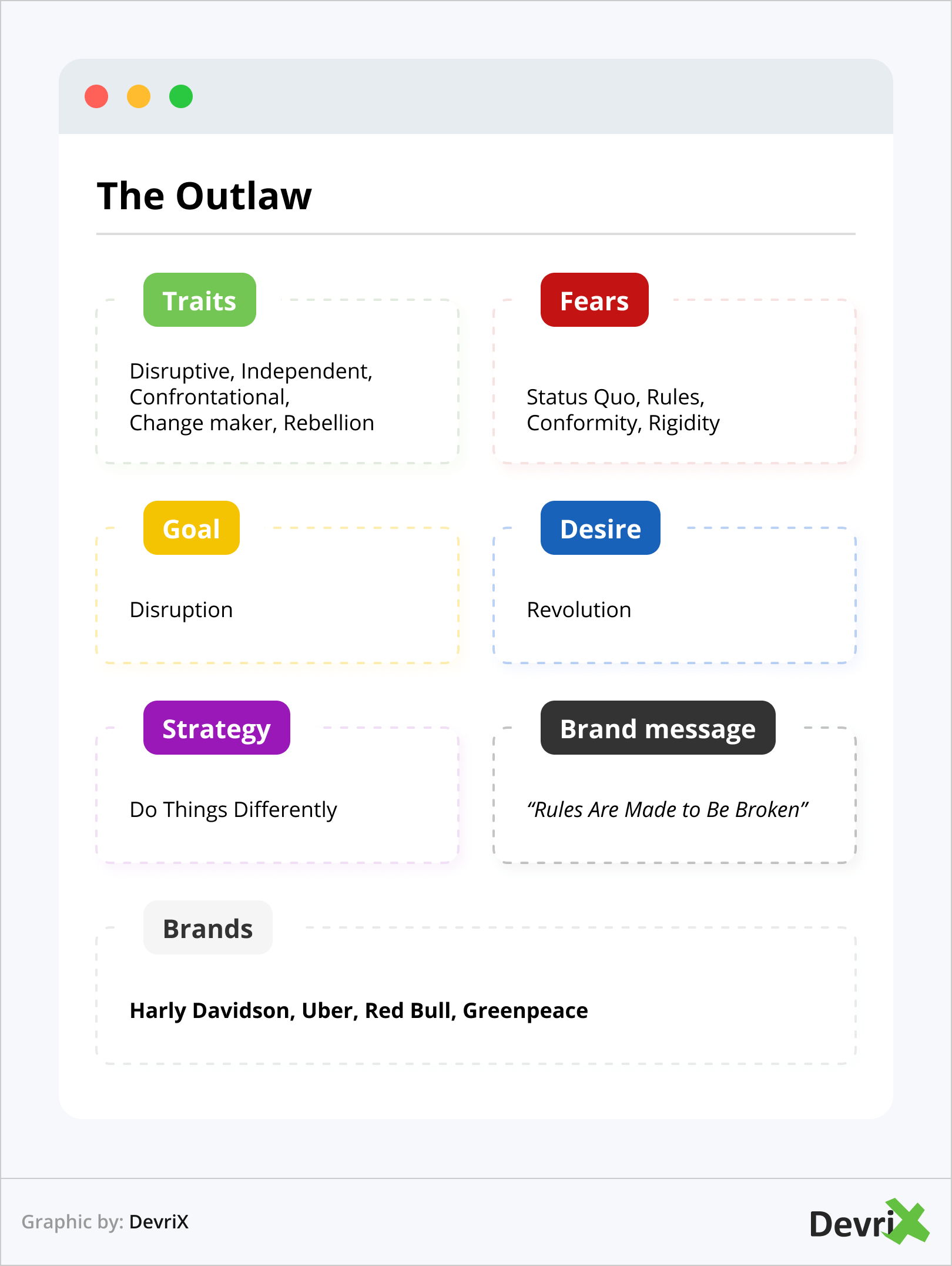
5. The Magician
This brand archetype strives to make dreams into a reality and create something special. Magicians are visionary and spiritual. They want to amaze their audience, by taking them on a mystical journey with new magical, exciting, and memorable experiences.
Similarly to the Sage, these brands also appreciate knowledge, but use it to realize their vision and share it with the world.

6. The Hero
Hero brands are on a mission to make a difference in the world. They are bold, courageous, and inspirational, with a strong sense of what is right and wrong.
Brands within this archetype believe that success comes from hard work and meeting challenges head-on. Moreover, they see their work as empowering and important, and, as such, are proud that this is what sets them apart.

7. The Lover Archetype
The lover archetype stands for passion, romance, and commitment. These brands are motivated by desire and seek to create intimate moments. They are usually empathetic and sensual, to appeal to their audience both physically and emotionally. But they can also be companionable, spiritual, and family-orientated.

Related: Brand Experience: A Comprehensive Guide
8. The Jester
Jester brands focus on bringing joy through humor, irrelevance, and fun. They don’t shy away from making mischief, seek to find the positive in every situation, and maintain a playful stance.
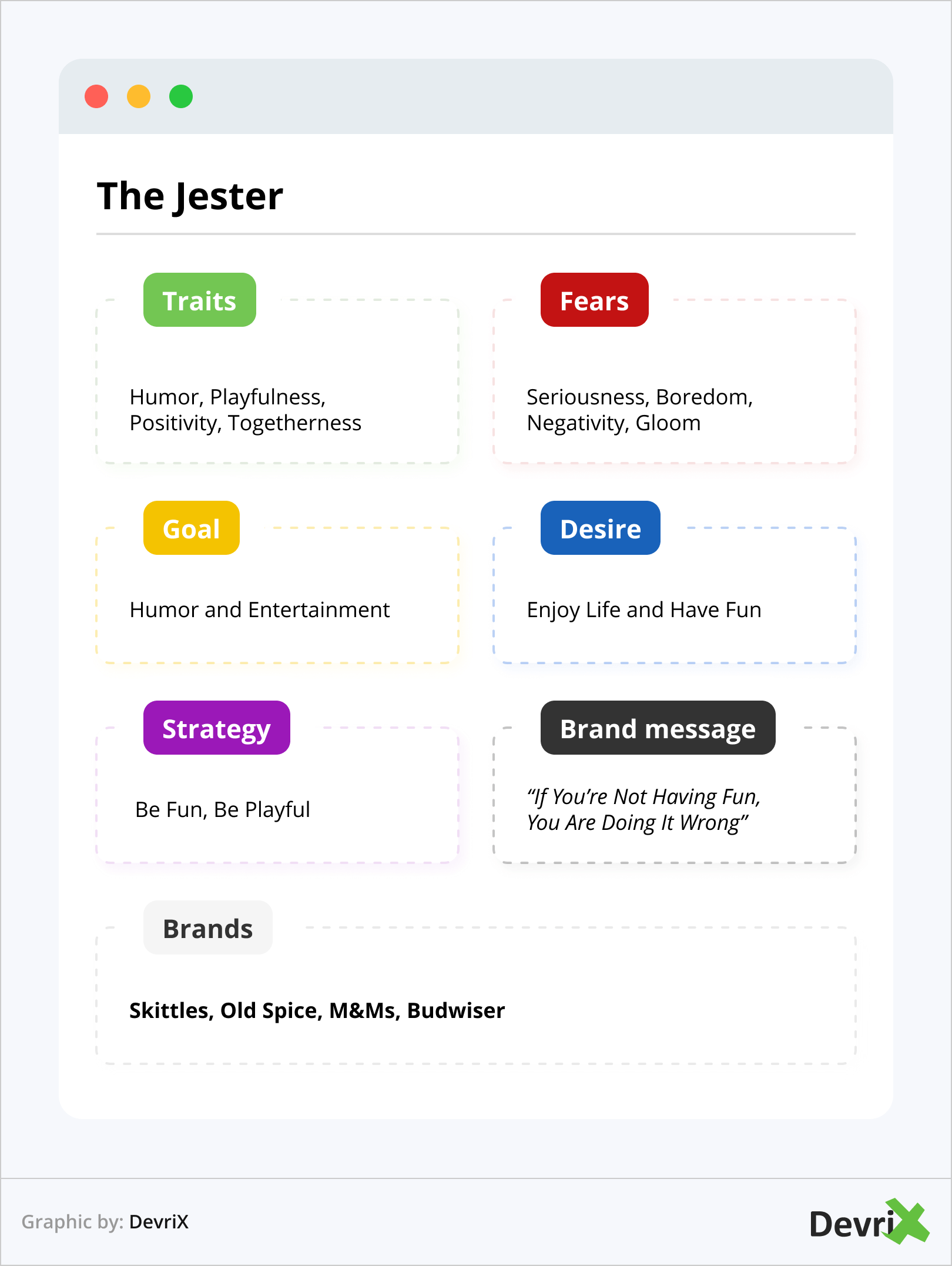
9. The Everyman
The Everyman archetype, also known as the Regular Guy, is a key player in the world of branding. This archetype seeks a sense of belonging and connection and is recognized for its faithful, supportive, approachable, and down-to-earth nature.
Brands that embody the Everyman archetype are driven by the desire to be part of a community, reflecting the core values of enterprise branding. They prefer to remain low-key and unassuming, aligning with the everyday experiences of their target audience. However, this can sometimes make them easy to overlook in the competitive landscape of brand archetypes.

10. The Caregiver Type
Brands with the Caregiver archetype are nurturing, compassionate, and generous. They like to protect and take care of others. They strive to create security and defend the less fortunate and are often associated with mother figures.
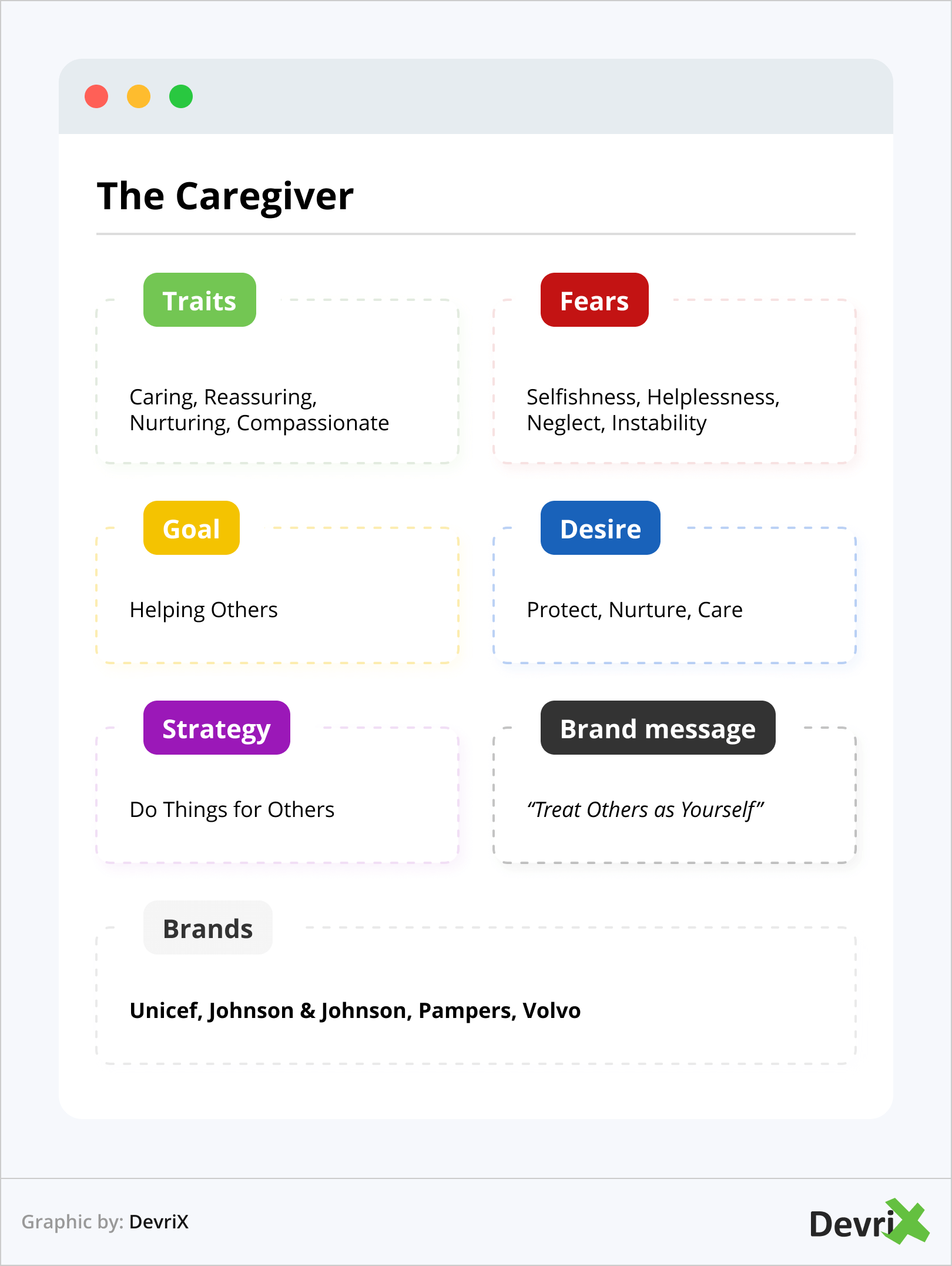
11. The Ruler
The Ruler archetype has a dominant brand personality type. It seeks power and control, likes to set rules, and expects others to adhere to them.
Ruler brands are proud of their expertise, and extremely confident, with strong leadership skills. Although they may come off as a bit narcissistic, they are, in fact, stable and trustworthy. Because they see themselves as leaders, they actively, and sometimes aggressively, protect their position in order not to be undermined or lose their power.

Related: Niche Marketing Strategy: 8 Techniques to Develop a Specialized Brand
12. The Creator Type
Creator brands are driven to create things that provide value and meaning. They are inventive and imaginative, like to push the boundaries of design and creativity and empower others to do the same.
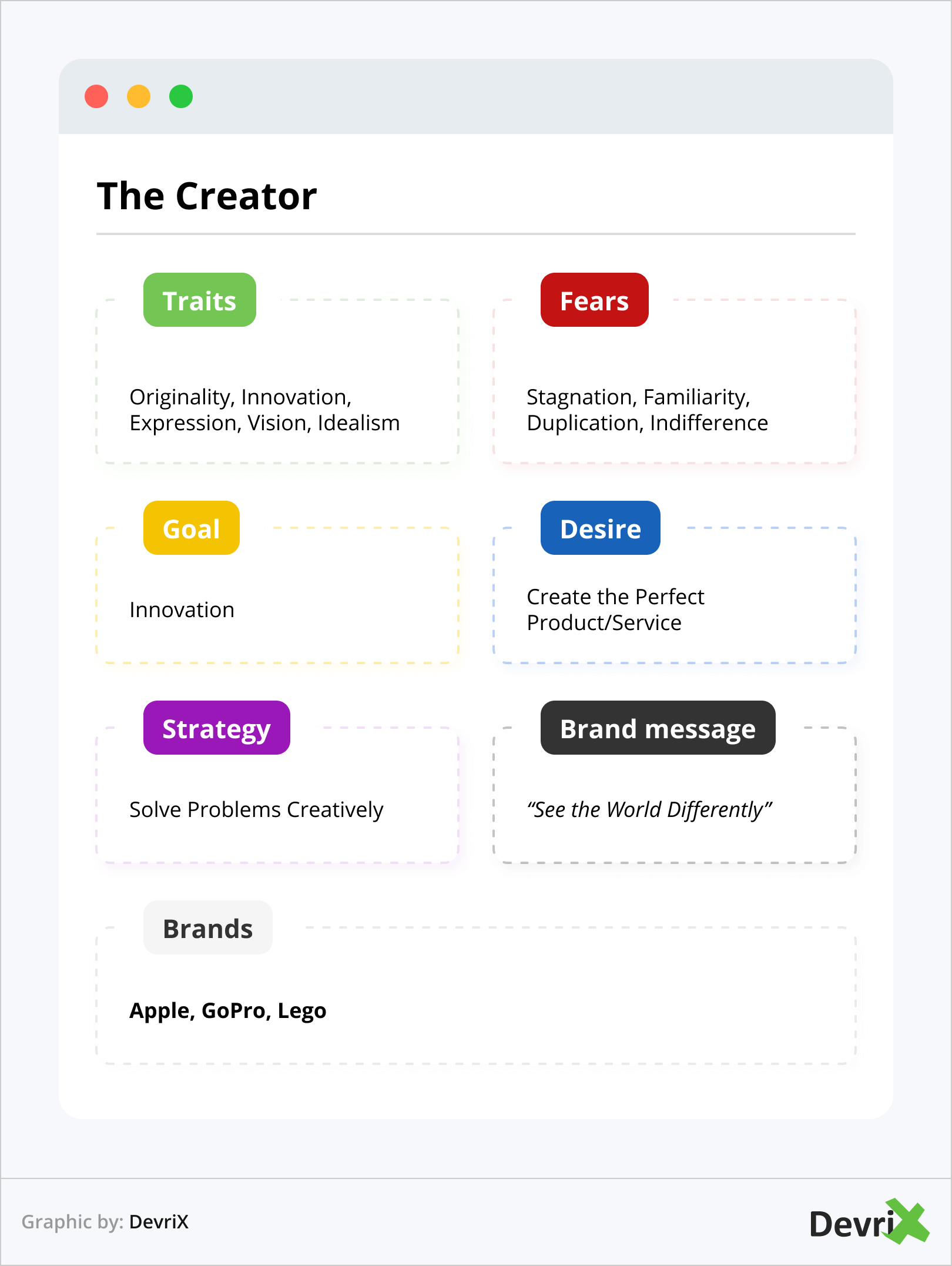
How to Define Your Brand Archetype
Depending on your industry, defining your brand archetype can be a bit tricky. One important thing you should remember is that your archetype should not be a personality you strive to achieve, but rather one who represents who your brand is already. It speaks to your values, and why you do what you do.
If you are not sure where to start, try the following:
1. Reflect on How Your Brand Started
Before you delve into the different brand archetype charts, wheels, and quizzes, you must have a clear idea of who you are as a business and brand.
We suggest you start by answering the following questions:
- Why do you do what you do?
- What values do you stand for?
- What impact do you want your organization to make?
Reflecting on what sparked your journey as a company is crucial for two reasons: establishing your branding core values, and formulating your vision and mission. These elements are fundamental in shaping your enterprise branding strategy.
Take, for example, two WordPress agencies. They may share similar core values, but their motives could be different. One agency might have been founded to simplify website creation and enable anyone to build a website regardless of their skills. This approach aligns with the brand archetypes of the Everyman or the Creator, aiming to democratize web development.
On the other hand, the second agency could be focused on assisting clients by crafting custom websites tailored to their business needs. This approach resonates with the brand archetypes of the Magician or the Hero, transforming the client’s vision into a digital reality.
Related: How to Use Value Proposition Canvas to Facilitate Business Success
2. Consider Your Audience
Even though your mission, vision, and values strongly influence your brand archetype, it’s also necessary to consider your audience – in particular, how will they connect and identify with your brand persona?
These are important questions because even if you try to present yourself in a certain way, your audience might put you in a different archetype.
For example, your brand personality type may feature characteristics of both the Creator and the Magician. And while you identify yourself as a Creator, your audience may see you as more of the Magician type. This, however, can be changed through setting clear brand guidelines and creating strategically designed campaigns.
3. Focus on the Right Emotion
Emotions are the reason why brand archetypes are so powerful and successful. You can always count on them to make people feel a certain way. They create chemistry between you and your followers allowing us to connect as human beings. Emotions tell a story and this makes them the perfect medium to convey your marketing message.
With this in mind, the next step towards building your brand archetype is to consider what emotions you want your brand to evoke.
For example, you’ve probably noticed that many chocolate brands portray themselves as Lovers. As such, their advertising focuses on building sensory experiences, emphasizing on texture, and connecting their products to romantic moments and gestures. They want you to feel the chocolate melting and experience the endorphins, just by watching the ad. And this is how they get you.
Related: How to Implement Emotional Engagement in Your Marketing Strategy
Using Brand Archetypes
Brand archetypes are powerful engagement tools. They help you create a human-like persona of your brand so customers can resonate with it on a deeper emotional and even personal level.
They help you align your company’s mission, vision, and purpose, pulling them together to create an intriguing, easily recognizable, and attractive force. As a result, your business can enjoy a better brand perception, greater advocacy, and a stronger and more loyal customer base.
